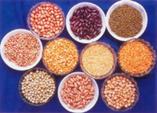Protein-calorie malnutrition
Protein-calorie malnutrition
Protein-calorie malnutrition (PCM) occurs as Marasmus (characterized by growth failure and wasting) and as Kwashiorkor (protein deficiency), characterized by tissue edema and damage. PCM increases the risk of death from pneumonia, chickenpox, or measles.

Causes
Both kwashiorkor and marasmus are common in infancy and childhood, when dietary amino acid content is insufficient to satisfy growth requirements. Kwashiorkor typically occurs at about age 1, after infants are weaned from breast milk to a protein-deficient diet of starchy gruels or sugar water, but it can develop at any time during the formative years. Marasmus affects infant’s ages 6 to 18 months as a result of breast-feeding failure or when there exists chronic diarrhea.
Signs and symptoms
Children with chronic PCM are small for their chronological age and tend to be physically inactive, mentally apathetic, and susceptible to frequent infections. Anorexia and diarrhea are common.
In acute PCM, children are small, gaunt, and emaciated, with no adipose tissue. Skin is dry and “baggy,” and hair is sparse and dull brown or reddish-yellow. Temperature is low; pulse rate and respirations are slowed. Such children are weak, irritable, and usually hungry, although they may have anorexia, with nausea and vomiting.
Unlike marasmus, chronic kwashiorkor allows the patient to grow in height, but adipose tissue diminishes as fat metabolizes to meet energy demands. Edema often masks severe muscle wasting; dry, peeling skin and hepatomegaly are common. Patients with secondary PCM show signs similar to marasmus, primarily loss of adipose tissue and lean body mass, lethargy, and edema.
Last Modified : 2/20/2020
This topic deals with information related to Anxie...
This topic deals with information related to Appen...
Acne causes, symptoms and remedies are described h...
This topic covers information about Amoebic Liver ...
